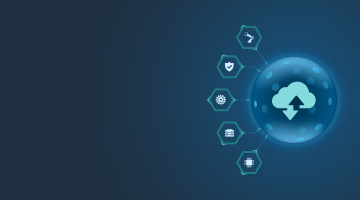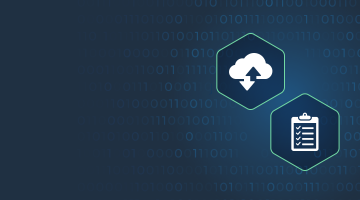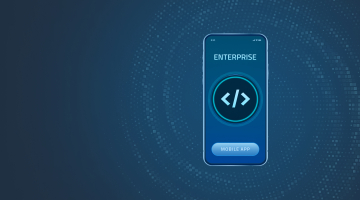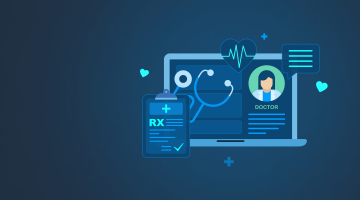

Cloud-based application development: Step-by-step guide
In 1997, Steve Jobs said, “I don’t need a hard disk in my computer if I can get to the server faster,” and named non-connected devices “byzantine.” Ten years before the launch of AWS, Jobs predicted that clouds would be a new standard. Due to the coronavirus pandemic, the world relies on cloud-based application development even more heavily now. COVID-19 forced many businesses to go remote and, respectively, work with the cloud environment, deploying it in their enterprise applications.
What is a cloud-based application?
Cloud-based apps are software products that rely on remote servers of cloud infrastructure to perform at least some processing or data storage while reserving a local foothold for other aspects of their operation. Such cloud solutions may be mobile or web apps accessed via a web browser. The typical tasks of cloud-based applications as vital elements of an enterprise’s IT ecosystem cover file storage and sharing, data collection, word processing, order entry, inventory management, customer relationship management, etc.
How do cloud apps work? Users interact with them via an interface connected to the back-end elements located on the remote data server run by cloud service providers. The cloud provider is responsible for ensuring the integration, data security, multiple access methods, and uptime of cloud-based solutions. Thus, cloud applications marry the portability of web apps with the interactivity of desktop solutions – a robust combination that ushers in numerous boons for cloud application users.
Are you looking for a cloud enablement vendor? Check what we do.
Benefits of cloud-based apps
Companies that go for cloud application development report the following advantages of such products.
- Short time to market. Cloud apps can be tested, updated, and deployed rather quickly, enabling organizations to react promptly to shifting market conditions.
- On-demand scalability. You can scale the capacity and resources the app consumes up or down according to fluctuations in demand.
- Automatic updates. These are delegated to cloud vendors, who grant them access to innovative features and issue security patches. In this way, out-of-date software is ousted without the participation of in-house IT teams, who are freed to attend to other errands.
- No-sweat management. Enterprises can outsource infrastructure maintenance to cloud service providers.
- Cost-efficiency. The sharp competition in the global cloud computing market stimulates providers to offer lower prices for their services, giving cloud-based apps an edge over more costly on-premises solutions in terms of maintenance and operation.
- Smooth data sharing. Data stored in the cloud can be accessed by authorized users 24/7, no matter how far from the cloud storage facility they are.
- Broad API-reliance. Thanks to a network of APIs, cloud-based apps can quickly receive access to various third-party resources, staying quite small in weight at the same time.
- Enhanced security. Cloud providers see that their infrastructure is penetration-proof and the data kept on their servers is backed up with high-end disaster recovery measures.
- Seamless collaboration. Cloud-based apps usually have advanced collaboration capabilities, allowing multiple users to collaborate on shared documents or participate in projects simultaneously. As a result, the company’s productivity soars.
- Gradual transition. You can refactor your legacy solution and migrate to the cloud step-by-step, embracing the new feature or functionality only after the users have taken the previous one in their stride.
Depending on the perks that matter most to an organization, it chooses the type of cloud application that best suits its current needs.
Types of cloud applications
Three basic cloud app designs prioritize specific functions and thus meet different requirements.
Software as a Service (SaaS)
This is the most common cloud app type by far. It boils down to third parties offering their clientele solutions running on their remote hardware. Google Drive, Google Docs, Dropbox, and Salesforce are probably the most popular examples of SaaS products. By harnessing them, enterprises avoid great upfront expenditures since they don’t have to splurge on costly on-premises equipment and permanent software. SaaS solutions operate on subscription models and require little customization, if any.
Platform as a Service (PaaS)
Per the name, PaaS provides an entire environment for software development and deployment. This ecosystem contains numerous tools, libraries, and frameworks, enabling developers to build, launch, and maintain cloud-based apps. Microsoft Azure App Service, Heroku, and Google App Engine are the best vendors offering PaaS.
Infrastructure as a Service (IaaS)
IaaS providers such as Microsoft Azure, AWS, and Google Compute Engine provide a robust infrastructure comprising servers, storage facilities, networks, and virtualization that customers can access via a dashboard or an API. This system allows users to control middleware, apps, and OS while the provider tackles hardware issues, outages, and maintenance.
Whatever type of cloud-based apps you choose, you will admit that cloud software can be extremely useful. It cuts IT infrastructure costs, improves flexibility, and supports dozens of interaction models between cloud providers, enterprises, developers, and users. It can help you to survive the crisis, grow, and attract new clients. Still, it’s vital to mind potential risks and pitfalls. Not all businesses require cloud migration, so you should know your goals and limitations. Also, it would help if you understood how to obtain a first-rate cloud-based solution.
A roadmap for creating cloud apps
Step 1—Start the project
The work begins here. To start making a cloud app, it’s a good idea to cooperate with a development company. A professional vendor that has designed many cloud solutions will mitigate project risks and handle all the main development, testing, and deployment steps.
First and foremost, pay close attention to preliminary agreements. They set the basics for your future cooperation. We suggest focusing on the following aspects:
- Approve the project. With your stakeholders, you should decide if your company needs the cloud app. Hence, you will be ready to cooperate more actively with the vendor and get a more tailored solution.
- Understand the scope. After the discovery phase performed by the vendor, you will understand what kind of functionalities your app should have, how many team members are needed to develop an app, what the main phases of the project are, etc.
- Plan development and testing. With a proper and detailed plan, the project will be much simpler. You will also know critical stages, KPIs, timelines, and expected outcomes.
A statement of work or SoW will be the first result. This document specifies requirements, timelines, and deliverables. As for costs, they depend on the project’s scope, complexity, and features. But we know one fact for sure: a cloud solution is cheaper than its on-premises alternative in the majority of cases. Just look at the estimation by Gartner that shows how the TOC drops by 55% after migration to the cloud.
Step 2—Analyze business requirements
To get a comprehensive solution, you should know the needs of users and stakeholders. Any software should provide value, and this stage helps to define which solutions, strategies, and models can maximize the benefits. Without a proper business analysis, you risk not getting what you expected.
Asking how to develop a cloud application, always keep in mind the desired results. Three major types of cloud software include cloud computing tools that add processing power, cloud databases that store info, and cloud software apps. A good example is our BenefitNet system developed for Teambase as a cloud app for insurers and employees.
Thus, consider the next tasks at this stage:
- Analyze current problems and solutions. Analysts can spot major gaps and weak links in your organization. Knowing them, you can choose the best solutions.
- Approve requirements with your partners. This point ensures that all participants in the development process are on the same page.
- Check the project plan designed by the vendor. You definitely want to know how the development will go. For this, study the plan and give your feedback.
- Reveal the expected results and KPIs. These wishes will act as main beacons for developers. And you will get exactly what you need.
The second official paper you will get is a business requirement document or BRD. It’s also known as SRS, which is a software requirements specification document. This doc specifies the demanded features of a cloud-ready application from your point of view. SRS is the main guideline for developers. It dictates which features the vendor should deliver and how it should do it. In a nutshell, SRS can significantly reduce further redesign tasks.
If you still don’t know whether you need a cloud app or no, read our Enterprise Software vs SaaS guide.
Step 3—Analyze the architecture and features
During the functional analysis stage of cloud-based application development, the dev team creates a traceability matrix, tests requirements, and researches specifications. Still, solution architecture design is the most important part. You should conclude all the features that are demanded to identify the best solution.
At this moment, pay close attention to two things: architecture and service model. A correct choice of both options will increase the efficiency of your app. Otherwise, it may become non-viable and not meet your requirements. If you’re confused, consult with the dev team – experts always know which approach will be the most suitable.
- Architecture. Classic solutions come as monoliths – single binary files. This approach is convenient but may be too rigid. Also, service-oriented (SOA) and microservice structures exist. They divide into functional modules that connect to each other but exist independently, making the product more flexible.
- Service model. Remember the types of cloud applications we discussed above? Models should match them. There are SaaS or on-demand software tools, PaaS, aka platforms, and IaaS, computing infrastructure. You can also find desktops (DaaS), banks (BaaS), storage (STaaS), and even disaster recovery (DRaaS) services.
For instance, developing RiskVille, we agreed that it’ll be a combination of PaaS and IaaS approaches with SQL storage. And the decision was right. Our customer now has more freedom in data/application management but doesn’t have to worry about tech things.
Step 4—Design your cloud application
Any cloud-ready application requires proper planning and designing. This phase is crucial because it helps you to move from ideas to real solutions. The development team focuses on high- and low-level design, as well as infrastructure requirements that are even more essential for cloud software.
To be precise, you’ll have to agree with the vendor on six core elements of the planned app. In the next sections, we describe top cloud providers and the most popular programming languages. Here, let’s focus on four other aspects:
- Database. It’s a place where you will keep your data. The vendor may offer relational or file-oriented storage, depending on your requirements.
- Message queuing system. This one is a protocol that connects apps asynchronously via API. As a result, senders and receivers don’t interfere with each other.
- Content delivery network. Known as CDN, this tool helps to deliver content to users quickly. Generally, it selects the closest cloud server to each user’s location.
- Container tools. To deploy the solution faster, leverage virtualization systems. We prefer Docker. It uses containers that consume fewer resources than VMs.
For different clients, we choose various tools for cloud-based application development. It’s better to be more flexible to choose the most suitable software elements. For instance, we used NServiceBus as a queuing system for the FSA – Flexible Spending Account platform. The reason is that this product relies on SOA with decoupled applications. Alternatively, for Azure cases, we can use Azure Service Bus as it’s a more native tool.
Here’s a master hint: don’t be afraid to get more from cloud providers. Often, teams like Amazon or Microsoft deliver various extra features. They offer messaging systems, CDNs, databases, etc. It’s a viable idea to use them to keep things under one roof.
Step 5—Bring the design to life
The title says it all. Once you planned and designed all core parts, it’s time to create your cloud application. The development stage is often divided into sprints, during which teams work on specific features or modules. It also includes source code reviews and tests in a controlled environment.
How do you develop a cloud application using the best tech? There are dozens of popular frameworks and languages. We choose the most modern languages that suit client projects. TIOBE and PYPL are programming language ratings with some examples of popular modern technologies. For back-end development, these include .NET, Java, Python, and Ruby on Rails. For the front end, there are React, Angular, and VueJS. Don’t forget to choose exact languages based on app features and project requirements.
For the already mentioned BenefitNet for Teambase, we selected .NET and Angular. These frameworks were the most relevant, considering the client’s wishes. Thanks to the correct selection of technologies, cooperation between insurers and brokers is continually growing, roughly by 25% each year since the release.
Look at how we develop cloud computing solutions to learn more about this stage.
Step 6—Test regularly to reach the top quality
Cloud-based application development requires proper testing. Clouds are more vulnerable to various failures and security threats. QA engineers run several sessions to avoid network shutdowns, data leaks, and software bugs. They check how the software works under different conditions, including real-world cases.
As a rule, we run the following tests:
- Acceptance – tests the software compliance with business requirements
- Disaster recovery – tests how the app reacts to disasters and how it recovers
- Interoperability – tests how different modules work together or with other apps
- Performance – tests how the system’s speed, stability, and responsiveness
- Scalability – tests the ability to scale up or down depending on the requests
- Security – tests the protection of the app from various cybersecurity threats
- System verification – tests if the app fulfills its main purpose
As well, at this stage, the vendor delivers initial training to your stakeholders who will use the cloud app. Additionally, we suggest preparing the production management controlled environments on your side. They will host extra tests during the next stage.
Step 7—Run user acceptance testing and training
If the previous step concerned general software tests, this one focuses on usage. At this moment, you will receive the next portion of training that will help end-users become more familiar with your software. After the performance and security testing, the vendor will update the cloud-ready application build and prepare for live proving.
The second big part of this phase includes production management. In the related client-side controlled environment, you should conduct more tests: dry run, disaster recovery, and business continuity (DR/BCP), operational acceptance. As a result, the product will be ready for deployment and final checks. It’s the last moment to make the necessary changes if you have any.
Step 8—Launch the app
The implementation provides for the live launch of the solution. Based on our experience, it’s essential to make live proving to check how the software works in the real environment. You can choose one of three cloud deployment types: public, private, or hybrid.
- Public servers are available for everyone. It’s a universal option that suits different companies and goals, allows quick scaling.
- Private clouds are reserved for the needs of one company. Choose them if you need total control over your IT infrastructure or have unique requirements.
- Hybrid clouds combine the best features of both structures. Get them if you work with several verticals simultaneously, have to switch between both types.
Learn more: Successful cloud migration plan
Talking about vendors that offer cloud spaces to businesses, there are three famous names:
- Amazon. Amazon Web Services, or AWS, provides numerous products, one of the most extensive networks of data centers, and powerful capabilities for all industries. Still, Amazon focuses on public clouds exclusively and has complicated pricing.
- Google. Due to the late start, Google has a lower market share than Amazon and Microsoft. However, Google Cloud offers amazing tech expertise in AI, ML, deep learning, Big Data, and advanced analytics. This advantage can be a game-changer.
- Microsoft. The platform Azure is AWS’s main competitor. Microsoft is the best choice for existing Windows customers and companies that opt for hybrid clouds. The main drawback is that it offers less professional support and training.
We often work with AWS and Azure environments. For the wearable health tracker Verisense by Shimmer, our developers worked with the client’s R/Python algorithms on AWS Lambda. According to the requirements, we designed a customizable Amazon-based cloud platform.
Step 9—Finish the project
That’s it. After deployment, you only need to sign closure documents and get final reports. They will finalize the developer-customer cooperation. After the launch, you can run the fresh application in your real environment, tracking all the issues or errors. Based on this post-launch test, the vendor can provide early life support with solutions for available problems.
This final stage is one of the most important collaboration parts for us. We provide the best early-life support to make the migration period to your new tool as smooth as possible. For example, we always analyze error reports and fix bugs immediately. Users learn from us through training. If needed, we can still make the necessary improvements based on the measured results during this early-life stage.
Successful implementation of the outlined roadmap is possible only if the development team avoids typical pitfalls the cloud app SDLC encounters.
Zooming in on cloud app development challenges
As a vetted IT vendor specializing in cloud solution development, DICEUS is aware of the four principal bottlenecks experts can encounter.
- Reliability. Round-the-clock uptime is one of the pivotal assets of cloud-based software. Yet, in real life, cloud providers may sometimes fail of this promise, causing disruptions in the business workflow of organizations that leverage cloud applications in their pipeline. To minimize such accidents, you should opt for a cloud service provider that guarantees consistent app performance even during a disaster.
- Portability and interoperability. As a rule, developers select one of the available platforms for app creation. However, the solution’s smooth functioning across other cloud environments is also vital since it allows app owners to switch to another provider in case of need. This problem should be handled during the project planning and code writing stages when the development team envisages broad compatibility of the future product and aligns its architecture with various cloud computing standards.
- Performance. The speed of operation is one of the significant requirements for software products. But while creating an app, you never know where the servers for its deployment are located and how long it will take for the data to be rendered. To forestall possible performance issues, you should analyze the future provider’s infrastructure beforehand and see if it will support your app. When the solution goes live, you should continuously monitor its operation and react promptly if you spot the app’s sluggish performance.
- Security. While the provider takes care of the security of cloud infrastructure, it can do nothing with the browsers customers leverage for accessing the app. That is why it is essential to adhere to cyber security protocols, implement data encryption, and use SSL on the client side to guarantee a secure connection and protect sensitive data.
Creating cloud applications with DICEUS
As you can see now, developing cloud-based applications isn’t rocket science. With the vast number of languages, tools, and cloud providers, businesses can quickly get their cloud solutions. We strongly suggest cooperating with a professional vendor that has successful cloud projects in different industries and regions. Thus, you can get the most tailored, cost-effective, and powerful app.
At DICEUS, we know how to design a cloud-based SaaS application. We work with insurance providers, banks, and logistics teams. Each client has unique pains and demands, so we tailor cooperation to deliver the results on time and spec. Hence, if you need assistance with any stage of the cloud development process, feel free to contact us.
FAQ
What are the key benefits of cloud-based applications?
By deploying the app on a third-party server, its owner obtains a secure, high-performing, flexible, and cost-efficient solution that can be scaled up or down on demand. Also, cloud-based apps play well with multiple external products, allow for robust data sharing and collaboration, and are foolproof in management. Their updating and maintenance are the responsibility of the cloud provider.
What is the difference between web applications and cloud applications?
A web-based app needs an uninterrupted internet connection to perform its tasks. Cloud-based apps require such a connection only for uploading and downloading data. Because these procedures do not involve internet coverage, cloud apps can operate without it, processing tasks on the locally situated computer or workstation.
What are the common challenges of cloud-based application development?
While planning and implementing cloud-based application projects, IT teams should ensure the solution’s round-the-clock uptime, lightning-fast performance, the security of the client-side operation, and the product’s wide portability, allowing its owners to change cloud providers at will and without delay.
How can you address security concerns in cloud-based development?
The provider is responsible for the security of the cloud infrastructure. However, app developers should handle the security of the client side. They should follow all security protocols (first of all, the Secure Socket Layer) and implement data encryption to safeguard a secure connection and prevent the compromise of sensitive data.
Are there specific industries where cloud-based applications are particularly advantageous?
Cloud computing is a disruptive technology that pervades multiple economic sectors, revolutionizing pipelines across all of them. Cloud-based apps are most readily used in banking, insurance, logistics, retail, government, and healthcare. Besides, they have huge potential in domains such as education, hospitality, automotive, real estate, etc.





